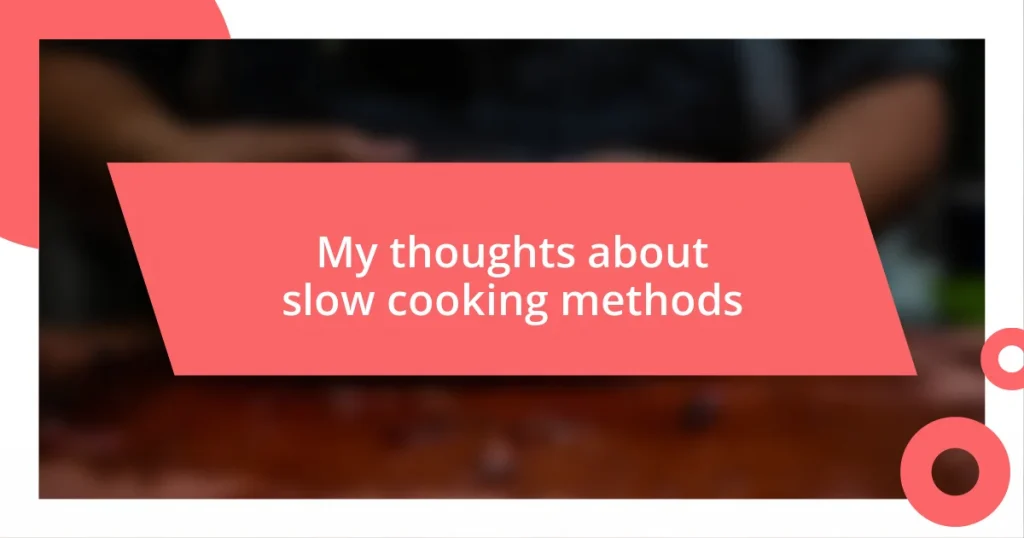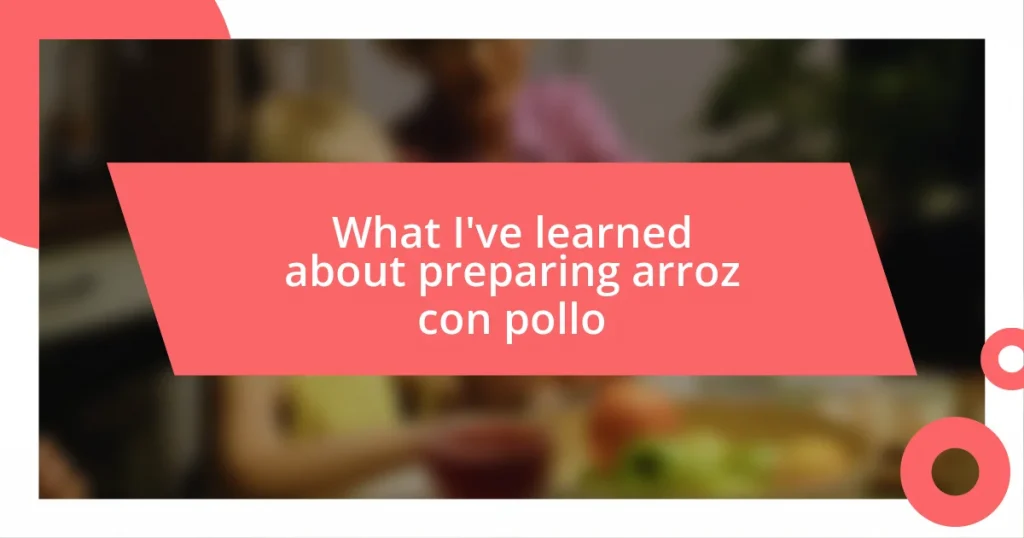Key takeaways:
- Slow cooking enhances flavors by allowing ingredients to develop rich tastes over time while retaining nutrients.
- Choosing the right slow cooker involves considering size, features, and ease of cleaning to improve the cooking experience.
- Enhancing flavors can be achieved through techniques like searing meat, using fresh herbs, and adding acids at the end of cooking.
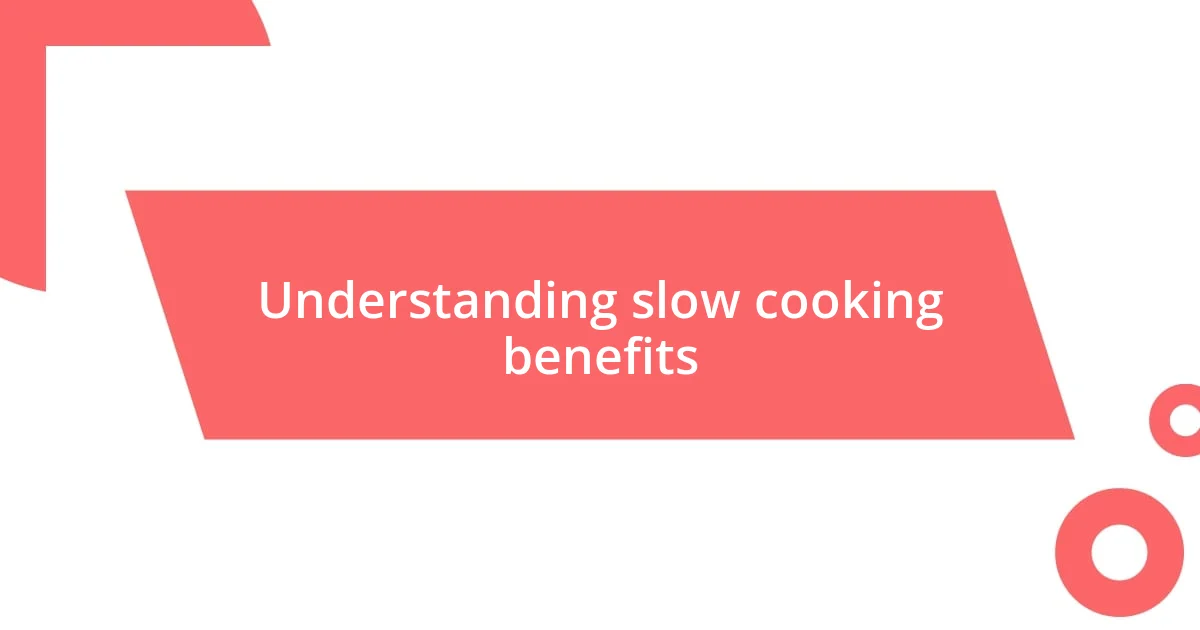
Understanding slow cooking benefits
One of the most significant benefits of slow cooking is how it develops flavors. When I first discovered slow cooking, I was amazed at how a simple pot of stew could transform over several hours into a rich, savory dish. Isn’t it incredible how time can turn humble ingredients into something deeply satisfying?
Additionally, slow cooking is remarkably convenient. I remember those hectic weekdays when I would prepare a meal in the morning, set my slow cooker, and return home to a warm, inviting aroma. It felt like I was welcomed home by the meal itself. How comforting is it to know dinner is ready without the hassle of cooking after a long day?
Moreover, there’s a health aspect to slow cooking that I cherish. Cooking at low temperatures helps retain nutrients, making your meals not just tastier but also healthier. I often think about how little effort versus the wholesome meals I create with my slow cooker. It’s like a culinary magic trick that rewards my patience! Isn’t it wonderful to savor a meal that’s both good for the soul and the body?
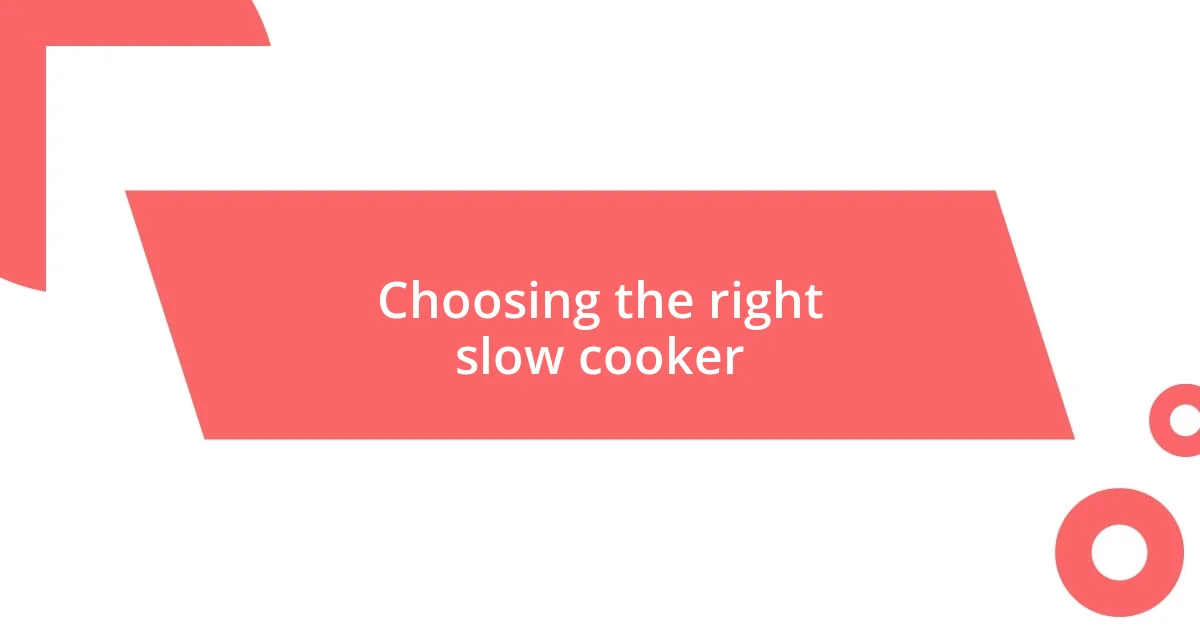
Choosing the right slow cooker
When selecting a slow cooker, it’s essential to consider the size that best meets your needs. I’ve found that having a model with a capacity of around 4 to 6 quarts suits my family perfectly. It’s just the right amount for cooking hearty meals like chili, while still having enough room for leftovers. Trust me, there’s nothing more frustrating than running out of space when you’re in the middle of preparing a delicious feast!
Here are some key features to keep in mind when choosing a slow cooker:
- Size and capacity: Consider your household size and how much food you typically prepare.
- Programmable settings: Look for models with timers and temperature controls for added convenience.
- Material: Decide between ceramic or metal inserts; I prefer ceramic for its even heating.
- Lid type: A glass lid lets you check the progress without losing heat, which I find incredibly helpful.
- Cleaning ease: Removable parts and dishwasher-safe components can save you a lot of hassle.
Taking the time to choose the right slow cooker can make a world of difference in your cooking journey. Once I settled on mine, it felt like my meal prep became easier and more enjoyable. Cooking became less of a chore and more of a delightful experience!
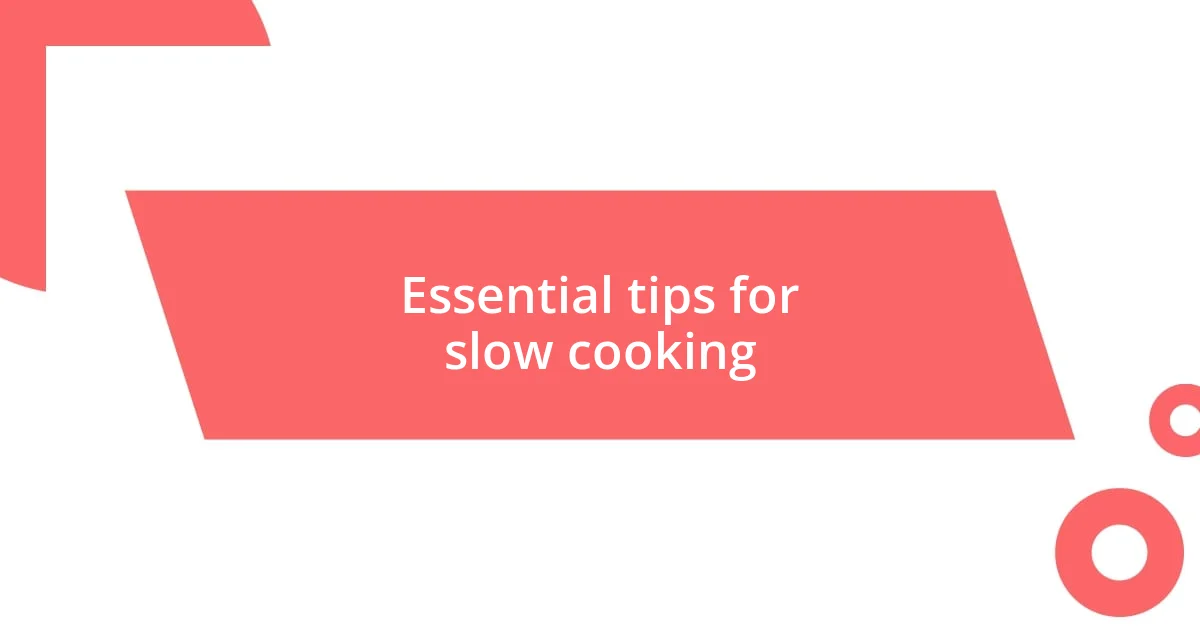
Essential tips for slow cooking
When I first started slow cooking, I found that preparing the ingredients ahead of time made the whole process smoother. Chopping vegetables and measuring spices in advance turned into a bit of a ritual for me, almost like meditation. It allowed me to focus on the flavors and combinations, which ultimately enriched my cooking experience.
Timing is another essential tip that I can’t emphasize enough. My relationship with slow cooking began with a lesson learned the hard way; I inadvertently overcooked a beautiful pot roast because I set the timer and forgot about it. Now, I always check recipe recommendations for cooking times. Generally, low settings are best for longer meals, while high settings can work if you’re short on time but still want that slow-cooked magic.
Using the right amount of liquid is crucial too. From my experience, I’ve discovered that too much liquid can wash out flavors, while too little can lead to a dry result. I usually start with about a cup of broth, then adjust based on the recipe and the ingredients I’m using. This balancing act of liquid really can make or break the dish!
| Tip | Details |
|---|---|
| Prep Ingredients Ahead | Chopping and measuring before cooking enhances focus and flavor combinations. |
| Mind the Timing | Follow recommended cooking times to avoid overcooking or undercooking. |
| Adjust Liquid Carefully | Balance the amount of liquid to retain flavors without drying out the dish. |
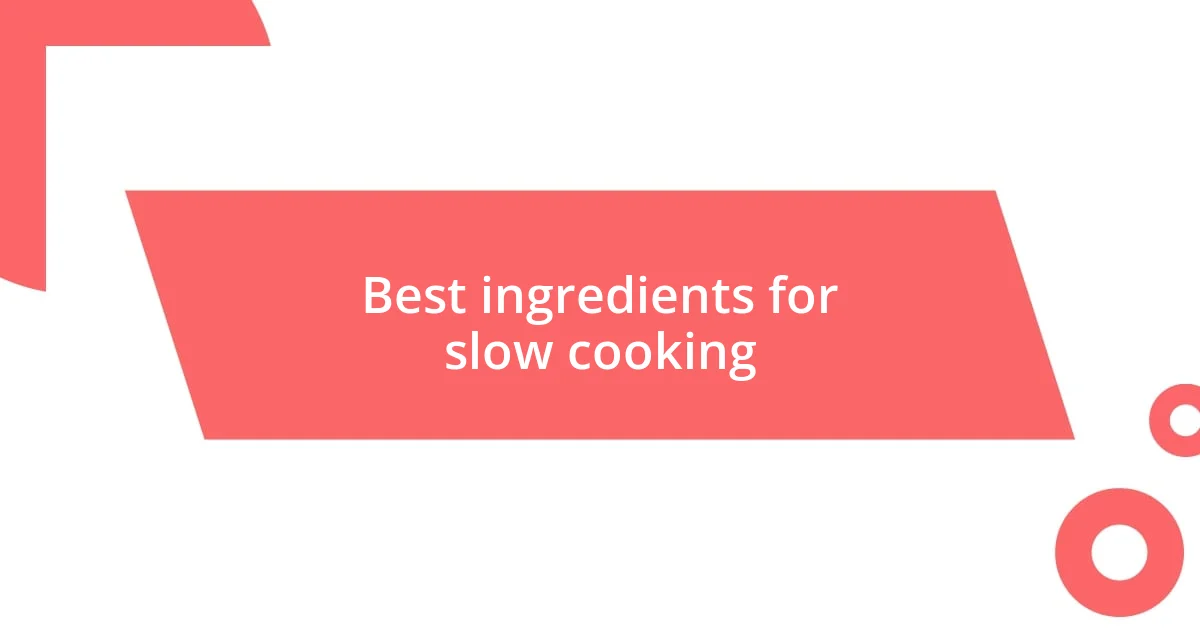
Best ingredients for slow cooking
When it comes to the best ingredients for slow cooking, I’ve learned that hearty vegetables truly shine. Root vegetables, like carrots, potatoes, and sweet potatoes, retain their texture and flavor beautifully over long cooking hours. I remember a time when I added in diced turnips, thinking they would just blend into the mix, but instead, they brought such a lovely sweetness to the dish that it transformed my whole chili recipe.
Meats are another essential component for slow cooking. Cuts like chuck roast or pork shoulder are my go-tos because they become tender and flavorful as they cook low and slow. The first time I tried a slow-cooked beef stew, I used a tough cut of meat and, honestly, I was amazed at how it practically fell apart with just a fork at the end of the cooking process. So, my advice? Don’t shy away from those inexpensive, tougher cuts—they reward you with tenderness and flavor that’s hard to beat.
Finally, herbs and spices elevate your dish from ordinary to extraordinary. Fresh herbs like thyme and rosemary can add depth, while spices like paprika or cumin inject warmth and character. Once, I experimented with a blend of smoked paprika and garlic powder on a simple vegetable medley, and the result was so delightful that I couldn’t help but share it with friends and family. Have you found a combination that transformed your dish? Exploring flavors is a journey worth taking in the world of slow cooking!
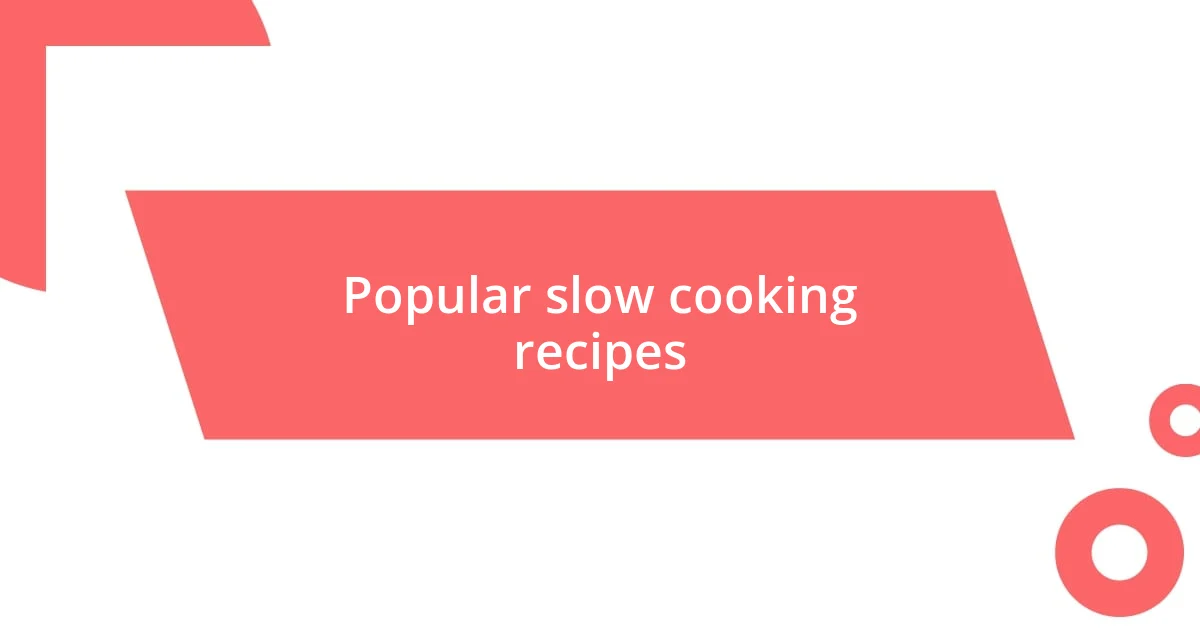
Popular slow cooking recipes
There’s nothing quite like a classic beef stew when it comes to slow cooking. I remember the first time I made it; the aroma filled my kitchen, wrapping around me like a warm embrace. Using a mix of chunky potatoes, tender carrots, and marbled beef, I left it to bubble away for hours. When I finally dug in, the flavors melded together beautifully, creating a symphony of savory goodness that brought my family back around the table, sharing stories and laughter. Isn’t that what we hope for—creating moments and memories over a shared meal?
Another popular option is pulled pork, which has become a staple in my slow cooking repertoire. I learned that a simple rub of brown sugar, paprika, and garlic powder can transform an ordinary pork shoulder into something extraordinary. The first time I served it at a friend’s barbecue, I was amazed to see people flocking back for seconds—there’s something incredibly satisfying about seeing friends genuinely enjoy what you’ve prepared. Does that kind of response fill you with joy too? It sure does for me!
Don’t overlook the beauty of a good chili as well. I often find myself experimenting with ingredients, tossing in beans, tomatoes, and whatever spice catches my fancy that day. One time, I decided to add a splash of red wine, and wow, did it take the flavor to another level! The beauty of slow cooking is that it invites creativity and experimentation. How often do you get the chance to innovate in the kitchen without the pressure of time? For me, slow cooking acts as a gentle invitation to play with ingredients and flavors while crafting delicious meals that nourish both body and soul.
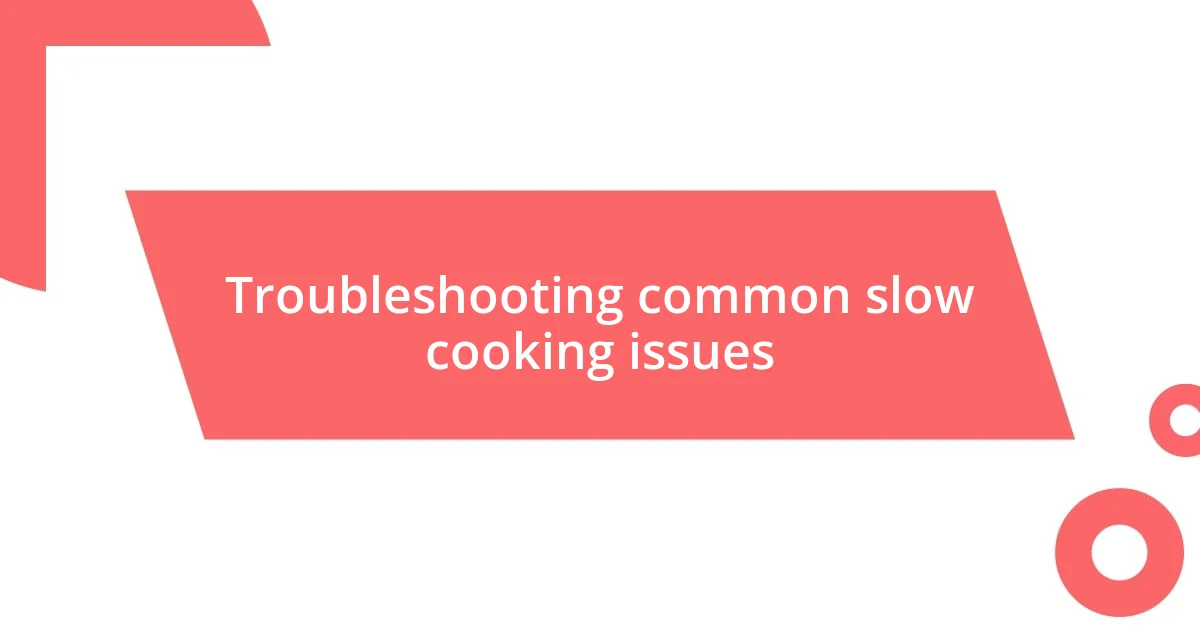
Troubleshooting common slow cooking issues
Slow cooking can sometimes throw us curveballs, and I’ve definitely encountered my fair share of issues. One time, I noticed my stew came out too watery, and it dawned on me—I forgot to account for the moisture from the veggies. A quick fix is to either reduce the liquids next time or remove the lid during the last hour of cooking to allow some evaporation. Have you ever faced a similar situation?
Another common issue I’ve found is that certain dishes can end up a bit bland, especially if you haven’t seasoned properly. I recall a chicken curry I made; it started bland and ended up needing a last-minute spice boost. I added a sprinkle of salt and a pinch of chili powder right before serving, and it ended up bursting with flavor. Remember, slow cooking can mellow spices, so taste testing is key towards the end of the cook time.
Finally, cooking times can feel unpredictable. I once set a roast to slow cook for eight hours, only to find it perfectly tender after just six. To manage this, I recommend checking on your food a little earlier than you might expect, especially when you’re trying a new recipe or cooking with unfamiliar ingredients. Have you discovered when your favorite meals hit that sweet spot of doneness? It’s always a bit of an adventure, isn’t it?
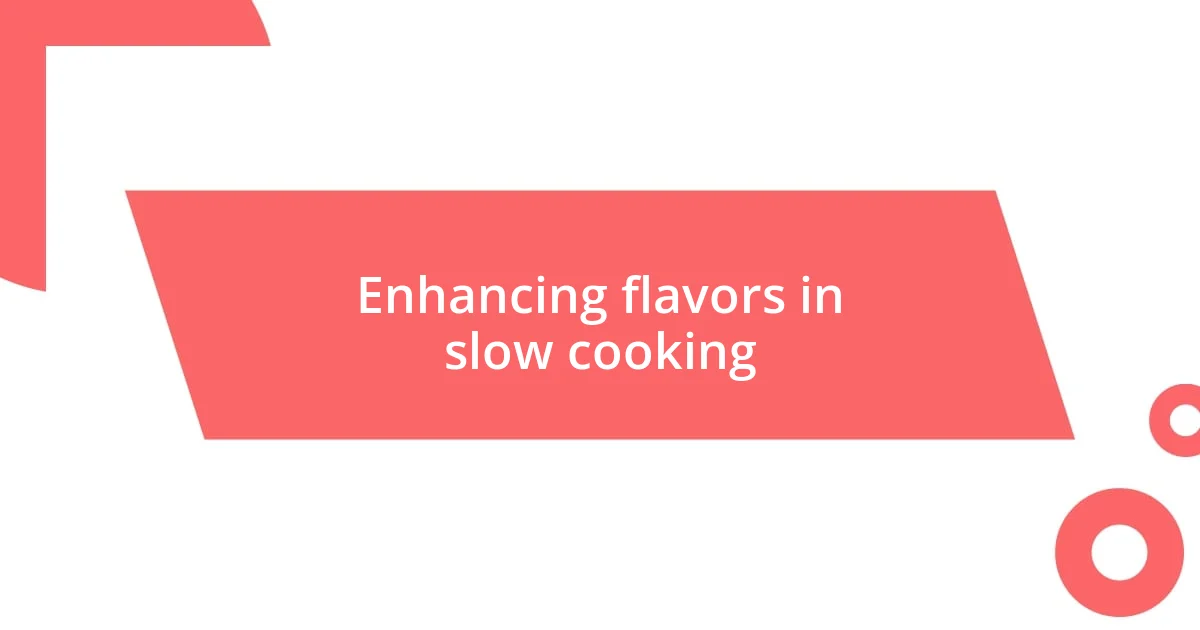
Enhancing flavors in slow cooking
When it comes to enhancing flavors in slow cooking, one of my favorite tricks is layering the ingredients thoughtfully. For instance, I often sear meat before placing it in the slow cooker. The first time I tried this with a beef brisket, the crust developed a rich, caramelized flavor that released into the dish as it cooked. It made me wonder—have you ever noticed how a slight extra step can elevate a meal from good to mouthwatering?
Moreover, the choice of herbs and spices plays a crucial role in flavor enhancement. I remember preparing a vegetable stew, where I decided to infuse it with fresh rosemary and thyme right at the beginning. By the time it was finished, the kitchen was filled with an intoxicating aroma, and the herbs had worked their magic, giving depth to every single bite. Do you ever stop and savor the bouquet of scents while cooking? It’s an experience I cherish every time!
Also, incorporating acids like vinegar or citrus at the end of the cooking process can truly brighten the flavors. I learned this when I added a splash of balsamic vinegar to a hearty lentil dish just before serving. The moment I took a taste, it was as if the flavors popped, bringing balance and a delightful tang. Isn’t it remarkable how something simple can make such a profound difference on your palate? That’s the beauty of slow cooking—small adjustments can lead to extraordinary results.










